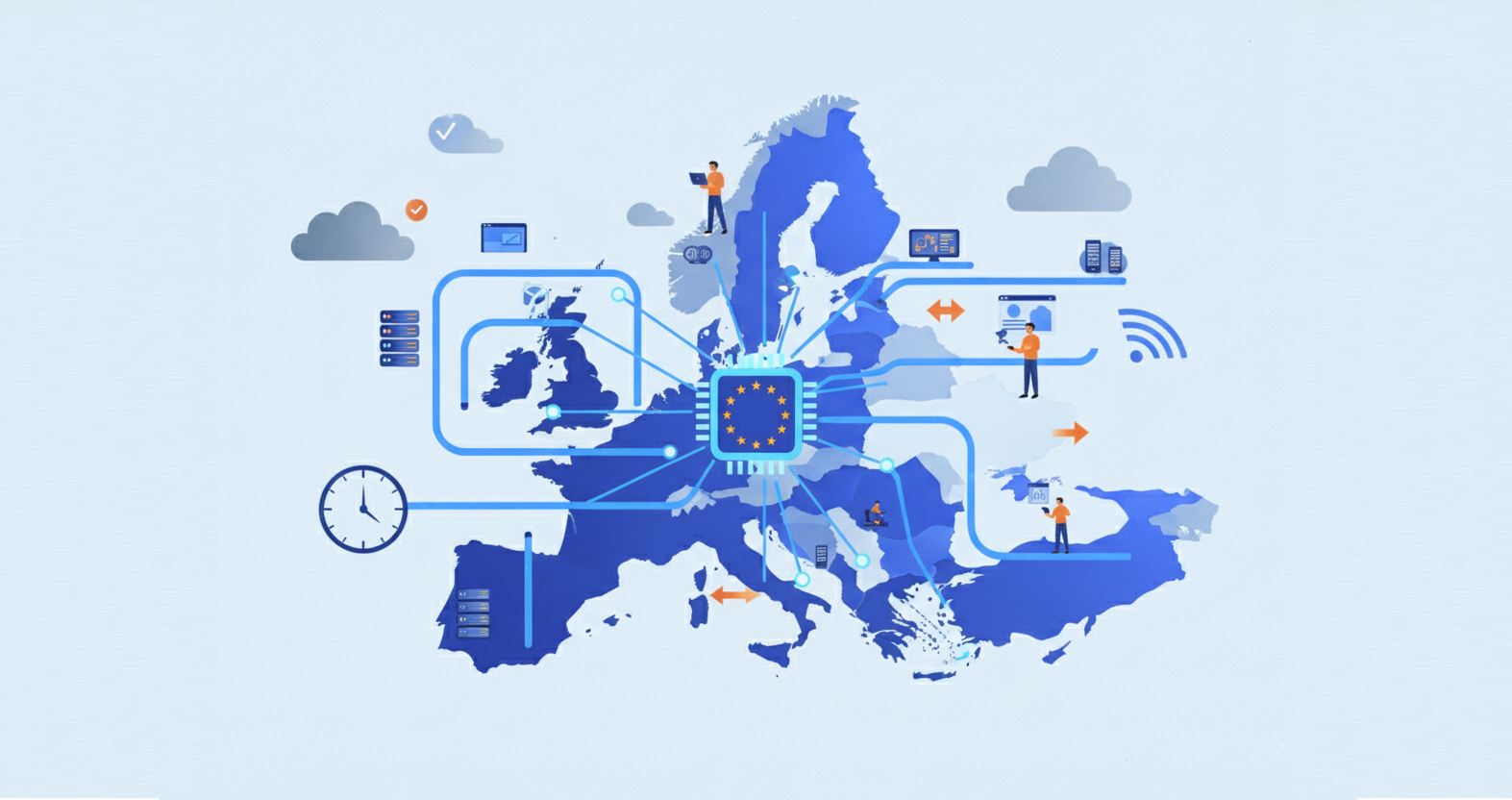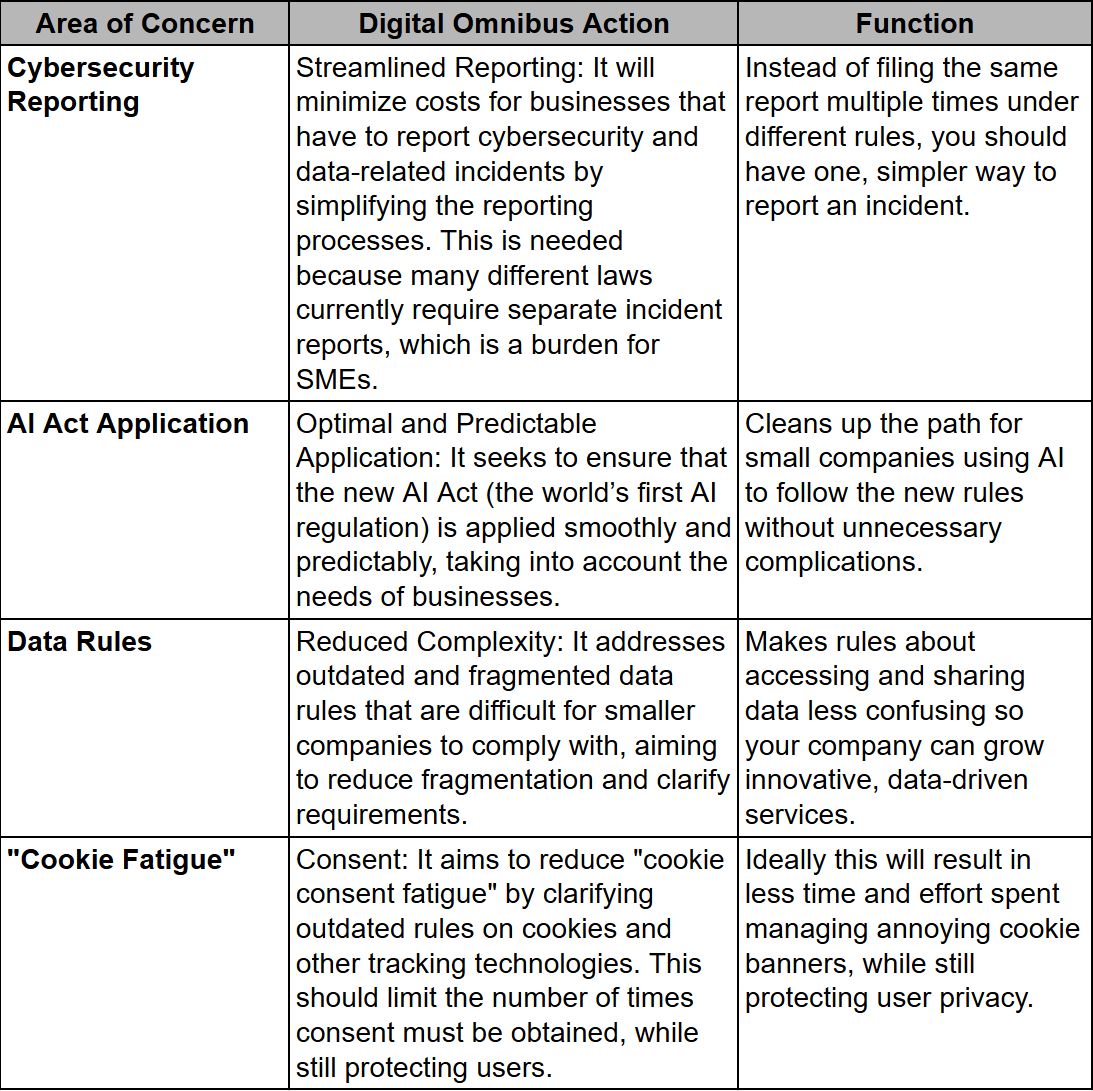A Simpler and Faster Europe: Regulatory Compliance Guide for Startups & SMEs

“A man is angry at a libel because it is false, but at a satire because it is true.” - Lord Chesterton

Good jokes are good jokes. Parody social media accounts can say things that corporations and governments can’t.
But there are real startups and real SMEs in the EU feeling the pain of regulatory burden right now.
Sergey is a solo founder building a screen recorder with auto-zoom called ScreenCharm.com. After winning his very first customers (an exciting moment for any business owner), German authorities informed him he was out of compliance with regulations and facing a fine bigger than his MRR:

Startups and SME owners feel the pain of regulatory burden more than big companies do. Big companies have entire teams dedicated to managing regulatory compliance.
Startups and SMEs have to figure it out themselves, which is opportunity cost. Every minute you spend digging through obscure legal language to figure out if some BS regulation applies to your business is a minute you aren’t focused on your customers, or cashflow, or growth.

Everyone can feel the regulatory burden choking SMEs and startups.
To their credit, the EU isn't blind to these realities. They are proposing big legislative changes to “radically lighten the regulatory load for people, businesses and administrations in the EU.”
To accomplish this, they’ve got a master plan supported by 4 major initiatives:
- A Simpler and Faster Europe
- Digital Omnibus
- Apply AI Strategy
- Revision of the EU Cybersecurity Act
- European Data Union Strategy
Collectively this is a huge amount of legislation, and legalese is nobody's favorite language.
We’re going to try to break it down to the most important parts, so you can understand what it means for your business.
1. The Master Plan: "A Simpler and Faster Europe"
"A Simpler and Faster Europe" is the big promise to radically lighten the regulatory burden for businesses and speed things up.
This document recognizes the current collection of rules became too complex over time, which hurts Europe’s ability to compete globally and limits economic potential for its citizens.
What "Simpler and Faster" Promises:
- Cut the Red Tape / Fight the Paper:
- The main goal is to make rules clearer, easier to understand and faster to implement.
- The main goal is to make rules clearer, easier to understand and faster to implement.
- Specific Targets for Savings:
- The Commission set ambitious goals for reducing the cost of following the rules, tying their success KPI to total administrative costs in the EU (150B in 2022).
- The KPI target for this entire program is to cut administrative costs by 25% overall (about €37.5B)
- Specifically for small and medium-sized businesses (SMEs), they aim for an even bigger 35% reduction.
- Their Main Tool: Omnibus Packages
- To do all this quickly, the Commission will use "Omnibus packages".
- An Omnibus package is a single bill that makes targeted changes to several existing laws all at once. This avoids having to reopen every law individually, making the simplification process faster.
- Focus on Small Businesses:
- The point of this whole (complex) simplification process is to make life easier for the EU’s 33 million SMEs.
- New laws will also be checked carefully to see how they impact SMEs before they are passed.
2. Implementation Steps: How the Master Plan Cascades
The "Simpler and Faster" plan directs specific teams to focus on areas that are especially complex and burdensome.
The 4 supporting documents (the Digital Omnibus, Data Union, AI Strategy, and the Cybersecurity Revision) are direct actions under this main goal.
A. The Digital Omnibus: streamline the rules
The Digital Omnibus focuses on making immediate changes to digital rules to achieve regulatory goals at lower administrative cost.
The goal is simple: reduce compliance costs and provide legal clarity for businesses:

B. The Revision of the Cybersecurity Act: modernize cybersecurity
The Cybersecurity Revision is an initiative to update the existing Cybersecurity Act (CSA) adopted in 2019 (a 600% increase). The revision is explicitly listed as supporting the Commission’s simplification agenda.
- Problem:
- Number and complexity of cyberattacks have increased significantly since 2019.
- Also, the existing framework for cybersecurity certification (ECCF) needs improvement in efficiency and clarity.
- Goal:
- The overall objective is to achieve a high common level of cybersecurity across the EU while contributing to the simplification agenda and reducing the administrative burden for businesses.
- They are specifically looking at how to simplify reporting obligations for businesses that stem from different laws.
The Cybersecurity revision is supposed to make security measures more streamlined and effective, so your company can be better protected without being crushed by complicated paperwork.
C. The Apply AI Strategy: accelerate growth in AI
The Apply AI Strategy is a strategic plan (not a legislative document) intended to serve as a blueprint to make Europe an “AI continent”. It directly supports the competitiveness goals laid out in "Simpler and Faster".
- Problem:
- The EU realizes that it’s not a leader in AI compared to the US and China, creating a technological dependency. This is very uncomfortable for EU leaders.
- Also, many EU companies, especially SMEs, struggle to adopt AI technologies (the report says only 13.5% had adopted AI by 2024).
- Goals:
- The strategy aims to boost new industrial uses of AI and help EU companies become global AI leaders.
- The strategy aims to boost new industrial uses of AI and help EU companies become global AI leaders.
- Support for Innovation and Startups:
- The strategy promotes innovation by building on key initiatives like AI Factories and GenAI4EU to help develop and deploy new AI models and applications.
- It will provide support through funding programs, shared data environments, and specialized skills academies.
- Trust and Standards:
- The strategy will complement the existing AI Act by supporting the development and use of "trustworthy, inclusive, and human-centric AI."
- The strategy will complement the existing AI Act by supporting the development and use of "trustworthy, inclusive, and human-centric AI."
D. European Data Union Strategy: create data assets
The European Data Union Strategy is a special lens within the overall simplification effort. It takes the big, abstract goal of "Simpler and Faster Europe" and focuses it intensely on the most complex area (data regulation and compliance with data regulation).
The stated aim is ensuring that AI innovation (the Apply AI Strategy) isn’t choked by administrative burden (the Digital Omnibus).
- Problem:
- “the EU lacks large data sets and needs to promote cross-industry coordination and data sharing to accelerate the integration of AI, especially generative AI.”
- “the EU lacks large data sets and needs to promote cross-industry coordination and data sharing to accelerate the integration of AI, especially generative AI.”
- Goals:
- This is a mandate for coherent strategy, and an explicit move toward consolidation of existing frameworks.
- This is a high-level recognition that the current system is riddled with inefficiency and uncertainty, especially for SMEs.
- Focus on Digital Compliance:
- The proposal to develop digital infrastructures to enable automatic compliance and potentially introduce mandatory digital reporting offers a concrete, technological solution to the complexity problem.
- For an SME, this means moving away from trying to manually interpret and file information under different, fragmented rules, and toward a unified digital system that manages compliance for them.
- If a unified digital system managing your regulatory compliance is interesting to you, check out Cybee’s automated regulatory compliance offering. It covers 27 regulatory frameworks including GDPR and DORA, automates evidence collection for each framework, and creates audit-ready compliance reports with 1 click.
- The proposal to develop digital infrastructures to enable automatic compliance and potentially introduce mandatory digital reporting offers a concrete, technological solution to the complexity problem.
- SME-Specific Relief:
- The strategy emphasizes that simplification will alleviate regulatory burdens for the whole economy, but especially for smaller and medium enterprises that have less capacity for compliance tasks.
- “The regulatory landscape on data use in the EU is marked by a complex mix of general and sector-specific laws, the interplay of which often is hard to understand for business enforced by different bodies or authorities, creating inefficiencies and uncertainties for businesses”. No kidding.
Summary
The central promise ("Simpler and Faster Europe") is that the EU acknowledges that regulatory burden is slowing down businesses.
The way this trickles down is through targeted actions:
- Digital Omnibus: Focuses on cutting costs and adding clarity fast, especially by making sure the new AI rules are practical for small companies and by simplifying complex reporting (like data breaches and cookie consent).
- AI Strategy: Provides a supportive environment and funding/infrastructure (like AI Factories) to help your innovative business scale and become a "global AI frontrunner".
- Cybersecurity Revision: Promises to modernize security rules and reduce the hassle of incident reporting by making those requirements less fragmented and complicated.
- European Data Union: Promises to reduce complexity and uncertainty around data privacy and data sharing in order to facilitate the growth of EU-native AI companies.
This entire effort is aimed at removing roadblocks and friction so startups and SMEs in the EU can focus less time and money on regulatory compliance, and more on innovation and growth.






